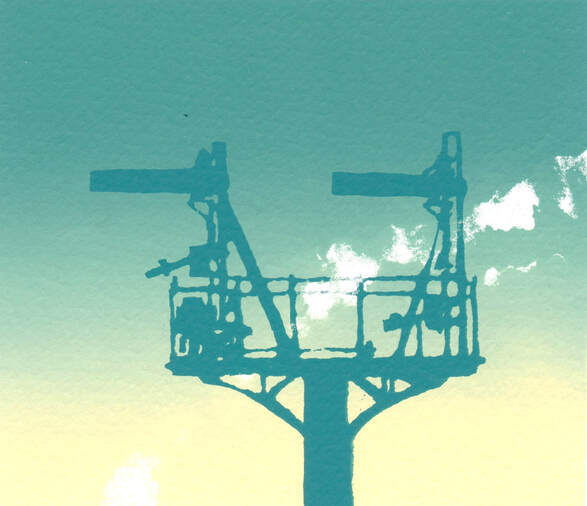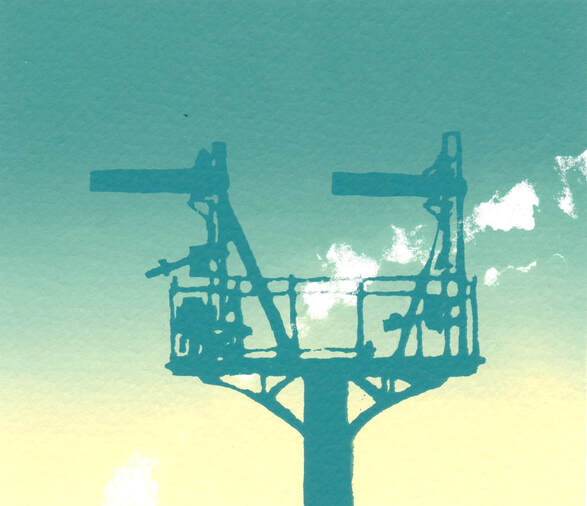Signals by Ian Scott Massie
Reduction Screen Print - Variable Edition of 11
12" x 12" Mounted size - 5" x 5" Image size
Available: unframed @ £75
To shop, please click here
12" x 12" Mounted size - 5" x 5" Image size
Available: unframed @ £75
To shop, please click here
THE NOR LOCH
Edinburgh is a beautiful city with a dark past, and Waverley Station is built right into it. When glaciers flowed across Midlothian in the ice ages, they divided at the volcanic rock on which Edinburgh Castle stands. Ploughing through the ground to either side they carved out what would become the Cowgate to the south and Waverley Station and Princes Street Gardens to the north. Fast forward a few years and, in 1460, King James III ordered the hollow to the north to be flooded as a defensive measure and the Nor Loch was created.
The loch soon proved a convenient destination for waste and sewage. The downward sloping closes running off the Royal Mile echoed to the cry of “Gardyloo” as buckets of slops, urine or worse were emptied and flowed down to the loch. The loch also proved useful to smugglers who rowed their contraband across its sludgy water under cover of darkness and it became a convenient place for suicides. But most notoriously it was a place of execution.
There was the horrifically titled “Swimming Test” in which a suspected witch would have her thumbs and toes tied together and pushed into the water. If she drowned she was pronounced innocent but, if she floated, she was taken up to the wide space outside the castle gates and burned. A memorial - the Witches’ Well - was created near the place of execution in memory of the 300 or so people who met their terrible end here.
Execution by drowning was a much-used method resulting, on one day in 1624, in the deaths of eleven women. One of the most chilling tales from the polluted water of the Nor Loch is that of the Sinclair siblings. Accused of incest, a brother and sister were placed in a large chest drilled with holes and thrown into the loch. 200 years later workmen digging a drain came across the chest. Inside were the skeletons of the unfortunate Sinclairs. The Nor Loch was eventually filled in during the 19th century but inevitably, during the construction of Waverley Station, a large number of bones were discovered.
The loch soon proved a convenient destination for waste and sewage. The downward sloping closes running off the Royal Mile echoed to the cry of “Gardyloo” as buckets of slops, urine or worse were emptied and flowed down to the loch. The loch also proved useful to smugglers who rowed their contraband across its sludgy water under cover of darkness and it became a convenient place for suicides. But most notoriously it was a place of execution.
There was the horrifically titled “Swimming Test” in which a suspected witch would have her thumbs and toes tied together and pushed into the water. If she drowned she was pronounced innocent but, if she floated, she was taken up to the wide space outside the castle gates and burned. A memorial - the Witches’ Well - was created near the place of execution in memory of the 300 or so people who met their terrible end here.
Execution by drowning was a much-used method resulting, on one day in 1624, in the deaths of eleven women. One of the most chilling tales from the polluted water of the Nor Loch is that of the Sinclair siblings. Accused of incest, a brother and sister were placed in a large chest drilled with holes and thrown into the loch. 200 years later workmen digging a drain came across the chest. Inside were the skeletons of the unfortunate Sinclairs. The Nor Loch was eventually filled in during the 19th century but inevitably, during the construction of Waverley Station, a large number of bones were discovered.



